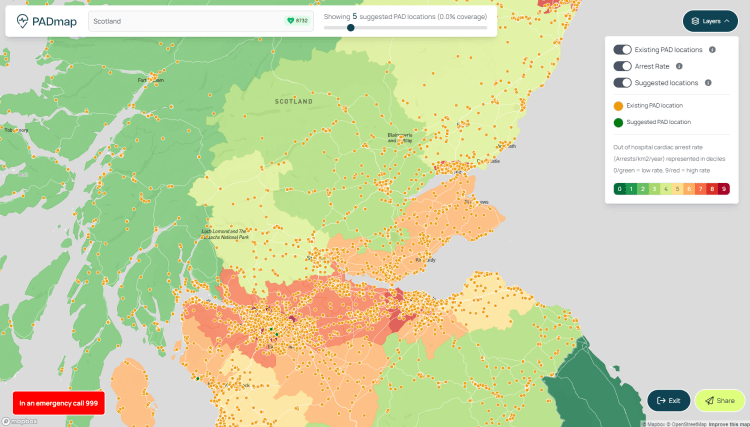
New Tool Boosts Cardiac Arrest Survival in Scotland
A new online tool launched in Scotland – based in part on research from the University of Toronto – aims to improve survival rates for out-of-hospital cardiac arrests by optimizing the placement of public access defibrillators (PADs).
Launched in March, PADmap is a website designed to guide the strategic placement of PADs, also known as automated external defibrillators (AEDs).
The tool was developed through a collaboration between researchers in U of T’s department of mechanical and industrial engineering in the Faculty of Applied Science & Engineering, the University of Edinburgh and designers at creative agency DaySIX. It was funded by the Scottish Government and St John Scotland.
Benjamin Leung, a graduate of U of T’s Applied Optimization Laboratory led by Professor Timothy Chan, explored defibrillator placement in Scotland as part of his PhD studies – and later played a key role transforming the research into a life-saving tool.
“It’s a great feeling to launch a concrete product that incorporates my graduate studies work and turns it into a real-world, problem-solving piece,” says Leung.
“Writing papers is an integral part of graduate studies but being able to turn that into a tangible result of the work is a really satisfying feeling.”
Leung first encountered Chan’s work with AED placement as an undergraduate student. Chan, meanwhile, was collaborating with the University of Edinburgh to address Scotland’s high rates of cardiac arrest by improving the deployment of AEDs.
With the support of funding from Mitacs , Leung spent a semester at the University of Edinburgh to develop and demonstrate a proof-of-concept for the tool. There, he worked with researchers in the university’s Resuscitation Research Group, as well as DaySIX designers.
“If we want to maximize our resources, we need tools like PADmap to show where the data says AEDs should go,” Leung says.
“Underserviced communities with higher elderly populations benefit from AEDs, and PADmap can pinpoint effective locations to place them.”
In a pilot study conducted in Falkirk, Scotland, 41 AEDs were installed using PADmap data. These devices have since been used at twice the rate of AEDs placed without the tool’s guidance.
Now, Leung and the rest of PADmap team are looking to expand the program.
“Other parts of the UK are interested in implementing PADmap, and we would love to expand into more communities,” says Leung, who is now a research fellow at the Duke Clinical Research Institute in Durham, N.C.
“The more we can co-ordinate and predict where AEDs will provide the highest success rate, the more lives we can save from sudden death.”
https://www.utoronto.ca/news/u-t-research-helps-power-new-tool-improve-cardiac-arrest-survival-scotland


